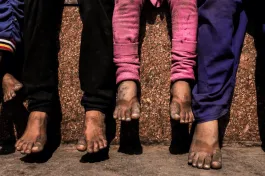In the 2021 Winter Session of Parliament, the government introduced a bill to raise the minimum age of marriage for women to 21 from 18, making it the same as the age for men. This came almost two years after a surprise announcement — in the budget speech of February 2020 — that the government was contemplating such a move. In July 2020, a task force was set up by the Niti Aayog to examine the issue, which invited interested parties to share their views. Although the task force’s report is yet to be made public, the government framed the amendment bill to the Prohibition against Child Marriages Act (PCMA) of 2006, which was then referred to a parliamentary committee. Responses from the public have once again been solicited.
To understand what is at stake here we must begin by noting that the new law intends to redefine any person who has not yet reached the age of 21 as a ‘child’. This is necessary in order to ensure that marriages below the age of 21 are prohibited with legal force, in other words, treated as ‘criminalisable’. The government’s rationale for doing this is listed in the unusually lengthy ‘objects and reasons’ section of the new bill (PCMA 2021). The list of ills that the proposed amendment intends to remedy includes everything from a woman’s physical, mental and reproductive health, to her disadvantages in higher education, employment opportunities, skill training and entry into the work force. No bill in recent times has claimed to address such a wide range of conditions.
These disadvantages, it is rightly said, perpetuate women’s dependency on men. The bill will also take on the challenges of improving maternal mortality, the sex ratio at birth, and the nutritional status of mother and child. The language is that of empowerment, ending discrimination, greater self-reliance, achieving the United Nations Sustainable Development Goals, and abiding by the UN Convention on the Elimination of All Forms of Discrimination Against Women, or CEDAW, which India signed in 1980. The bill claims that equality, one of the foundational values of our Constitution, will be “holistically” realised through equality in marriageable age.
Given that many women’s and children’s rights organisations and activists (including myself) have come together to oppose the proposed new law, a strange face-off is being staged. According to the objects and reasons of the PCMA Bill 2021, the government is acting to empower women and protect children, and, yet, those who profess to work for the rights of women and children oppose this action!
To make sense of this apparent contradiction, we need to situate the 2021 law within the larger historical context of 130 years of state-society conflict on the age of marriage for girls and women.
Scenes from history
One has to go back to the late 19th century — when social reform was at its height — to get a sense of the enormous stakes that once surrounded women and their low status in society. Regulating marriage was pivotal in agendas of social reform, and age became the fulcrum.
The first major campaign around a woman’s age was not only about marriage but rather around the capacity to enter sexual relations of any kind, whether through marriage or prostitution. Liberal proposals to raise the age of consent for girls above the age of 10 years (as per the colonial Indian Penal Code at that time) brought thousands onto the streets in protest. The historian Tanika Sarkar has demonstrated how the first nationalists defended infant or child marriage as a 'marvellous' Indian custom, the core of Hindu culture. The balance of political forces was upset only by the death of a girl (said to have been 10 or 11 years old) due to violent sex at the hands of her much older husband. This led to the Age of Consent Act of 1891 that raised the age of consent to 12 years. (Sarkar 2001).
By the 1920s the stage had widened to include the geopolitical realignments of the interwar period. Efforts to further raise the status of women through age at marriage saw both domestic and international players joining the controversy (Sinha 2007) and it being portrayed in misleadingly simplistic terms of a battle between tradition and modernity, or between religion and science (Pande 2020). The Child Marriages Restraint Act (CMRA), better known as the Sarda Act, was finally passed in 1929, raising minimum ages of marriage for women to 14 and for men to 18 years for all communities.
Ironically, we know much more about the late colonial period, which has been studied intensively by social historians, than we know (as yet) about the subsequent post-Independence decades of the 1950s and 1960s, not to speak of the decades beyond. The Special Marriages Act of 1954 and the Hindu Marriage Act of 1955 prescribed minimum ages of 15 for girls and 18 for boys. According to Ashwini Tambe (2019), even after Independence, international contexts continued to play a decisive role in debates about women’s age at marriage.
The next major moment came after the lifting of the Emergency in 1977. There was not even a ripple of dissent when the CMRA was amended in 1978, making 18 and 21 the new minimum ages at marriage for women and men, respectively. The objects and reasons of the 1978 amendment were short and succinct. They made it clear that the new law was intended to be a population control measure, because raising the age at marriage could lower the total fertility rate and hence check population growth. As an afterthought, it was mentioned that it would “also” result in more responsible parenthood and better health of mother and child (CMRA 1978).
[H]igher age of marriage does not cause better health or education, all three are “caused” by the economic status of the family.
In my own research, I have emphasised other equally pertinent shifts in perspective as we move closer to our own time (John 2021). After Independence, social change was seen through the lens of development, unlike in colonial times, when it was seen primarily through the lens of culture. The daughters of an emergent middle class — led by the Hindu upper castes — were now being groomed to become 'suitable girls' for a different generation of men. They were no longer child victims of traditional customs, as their mothers or grandmothers may well have been.
Alongside these transformations, the new nation’s elite effectively redefined child marriage as the problem of the Other: those at the wrong end of development, the poor, or the socially marginal. Child, or 'early', marriage moved from being the problem of 'people like us' — the families of social reformers themselves — to becoming the problem of backward regions and disadvantaged social groups, where daughters were being married off 'too soon'.
Some statistics for the present
Since history shows that perceptions about age of marriage have changed significantly — 10 was once considered appropriate but today the government believes it ought to be 21 — we need to look at what data tells us about this issue.
As several commentators have noted, census data shows that the mean age at marriage for both women and men has crept upwards. Rates of underage marriage below the age of 18 years for women have also correspondingly declined. Graph 1, based on census data, shows that barring the dip in 1931 (when families clearly rushed to marry off their daughters before the Sarda Act of 1929 came into effect), the mean age at marriage for women has steadily climbed. The upward trend has continued after the CMRA Act of 1978.

These trends can be confirmed from National Family Health Surveys (NHFS), which, like the census, has reported significant declines in marriages below the age of 18 in recent decades. NFHS-3 data for 2005-06 shows that almost half (47.4% to be precise) of the women in the age group 20-24 years had married before they were 18. The next round, NFHS-4 (2015-16), shows that this figure had dropped to 26.8%. The provisional data in latest fact sheet from NFHS-5 (2020-21) puts this figure at 23%.
Among the 26.8% of women in 2015-16 (NFHS-4) who had married before they were 18, only 6.6% had married at an age below 15 years. The current picture would therefore be better described as declining trends of adolescent or early marriage rather than child marriage. My own analysis of NFHS-4 unit-level data (also shared with the task force in 2020), shows that the overall proportion of those in the age group 20-24 years who marry before reaching 21 years is 56%, but when we look at the poorest 20% of the population this figure goes up to 70%.
There are many ways to look at these figures. Some of us say that marriage ages are going up, while others say they are not going up fast enough. Furthermore, some of us say that the issue here is the minimum age at marriage, while the government talks about the 'right' age at marriage, creating confusion.
Before going any further, it is crucial to confront the extravagant claims about how raising the age of marriage to 21 years will lead to women’s empowerment and equality on several counts. Among the most striking aspects of the available data on age at marriage is that once we cross the age of about 15 years, age seems to matter comparatively much less as a possible causal factor when looking, for instance, at health and education. There is certainly a positive correlation between age at marriage more generally and these indicators. But this is because better off families with better access to nutrition, health and education marry their daughters at correspondingly higher ages today, compared with the situation a century ago. In other words, higher age of marriage does not cause better health or education, all three are 'caused' by the economic status of the family.
Among the middle classes, the suitable girl for today’s suitable boy has to meet stringent requirements within an intricate but staunchly patriarchal marriage market. Education among men has led the way here, with professional qualifications raising the benchmark for male ages of marriage, with ages in the mid- to late-20s (up to the early 30s) being the most common. With some regional and caste variations, the suitable girl has, over the years, inched her way up into the 'proper' kind of age difference (usually less than five years) in order to become the companionate wife and mother of future children. The matchmaking search has expanded with the aid of all kinds of old and new intermediaries, from caste and community organisations to newspapers, marriage bureaus, and now online platforms (Kaur and Dhanda, 2014).
[I]t is meagre employment opportunities rather than early marriage that is preventing women from becoming more economically self-reliant and empowered.
However, the crucial point here is that a higher age at marriage does not lead to better outcomes in cause-effect fashion. Statistical analyses that control for other factors (such as wealth, access to health care, education and so on) reveal that beyond 18 — and sometimes even a year or two below it — the age at which a woman marries is the least significant factor in determining whether she will die in childbirth or produce an underweight baby. A woman who is poor and has no access to proper nutrition or health facilities does not become healthier or less poor merely because she delays her marriage by a few years.
For example, anaemia is our biggest cause of maternal mortality, and India has some of the worst figures in the world. But data shows that women’s anaemia levels get no better when the age of marriage rises above the age of 21. On the other hand, NFHS-4 shows that they improve considerably when we move up the economic status scale, even when 'up' means just above the poorest 20%.
The biggest paradoxes are in employment, or more accurately, paid work. India happens to be amongst the countries with the lowest rates of employment for women. However, even these already low rates have been declining in recent decades. The alarming state of women’s employment is rarely connected with issues like age at marriage. We find that not only has employment for women fallen in the very years when ages at marriage have been increasing, but the proportion of employed women declines as we move to higher ages at marriage. In other words, poorer women are both more likely to have paid employment and to have married earlier, while better off women marry later but are less likely to be employed (John 2021, 165).
Thus, it is meagre employment opportunities, rather than early marriage, which prevents women from becoming more economically self-reliant and empowered. Of course, housewives perform critically useful labour of many kinds, but they remain economically and socially dependent on men.
What will a legal fix achieve?
There is a final argument that can sidestep the overwhelming evidence that shows the raising of age of marriage will not lead to empowerment of women. This is the negative one that says: even if there is no major benefit, what is the harm in raising the marriage age? Is it not a good thing that it would (potentially) break the age-old patriarchal belief that the bride should always be younger than the groom? So why are opponents being so contrary?
What is even stranger is that a state that claims to be so eager to empower women shows no signs of creating the actual enabling conditions that would make women lead more autonomous lives.
My answer is simple: this attempt to fix something that is not broken will instead do immense harm.
Though the average age at marriage is now above 20, a very large proportion of women in the age group 20-24 years married before the age of 21 — 56% in all, as per NFHS 4 (2015-16) data, and 70% of the poorest fifth. The new law will bring large numbers of young people and their families into zones of illegality, robbing women of the legal protection that marriage provides. The existing PCMA 2006 is what is called a voidable law, which means that the 'child' or her parents or guardian can get the marriage nullified, while the 'adults' involved — from husband and family members to those organising the marriage— can be jailed for two years and fined Rs 1 lakh.
One can well imagine how a selective application of this new law would work itself out, on which occasions the law may look the other way and where it would not. Neighbouring Nepal recently raised the age of marriage to 20 for women, equal to that of men. Nepal has a no-exception law, such that a marriage undertaken before the age of 20 stands immediately annulled. They are now faced with the reality of abandoned young women in crowded women’s shelters. States like Karnataka and Haryana already have no-exception laws in their statute books. How can these legal moves be a step forward?
What is even stranger is that a state that claims to be so eager to empower women shows no signs of creating the actual enabling conditions that would make women lead more autonomous lives. Education has become increasingly expensive and decent work is vanishing. Budgets for health care are a fraction of what they should be.
International agencies pushing for the elimination of child marriage globally have always been motivated by population control. Empowerment is only a recent feel-good addition that is mostly cosmetic. In fact, organisations such as the World Bank openly argue that raising the age of marriage will bring massive savings in health investment due to fewer children being born, even though it will not lead to greater gender equality as measured by greater decision-making power, reductions in levels of violence, or employment opportunities (Wodon et al 2017).
Our goal as women’s and child rights activists can never waver from genuine steps toward empowerment and equality. But if the moves being suggested will do more harm than good, we must have the courage to say so. The struggle for gender equality will have to be fought by all women, regardless of their status and the age at which almost all of them may have to marry. Dependency and lack of autonomy haunts the lives of those who are marrying at perfectly legal ages under the proposed new law. Large numbers who are already vulnerable by virtue of class, caste, region and minority identity can lose their legal status for having suddenly been redefined as children when they are young adults by all international conventions, and are majors by the laws of the land.
We can only hope that the parliamentary committee will take its job seriously and listen to the reasons why the move to raise the age of marriage for women, however well intentioned, may end up worsening the very situation that it is supposed to improve.









